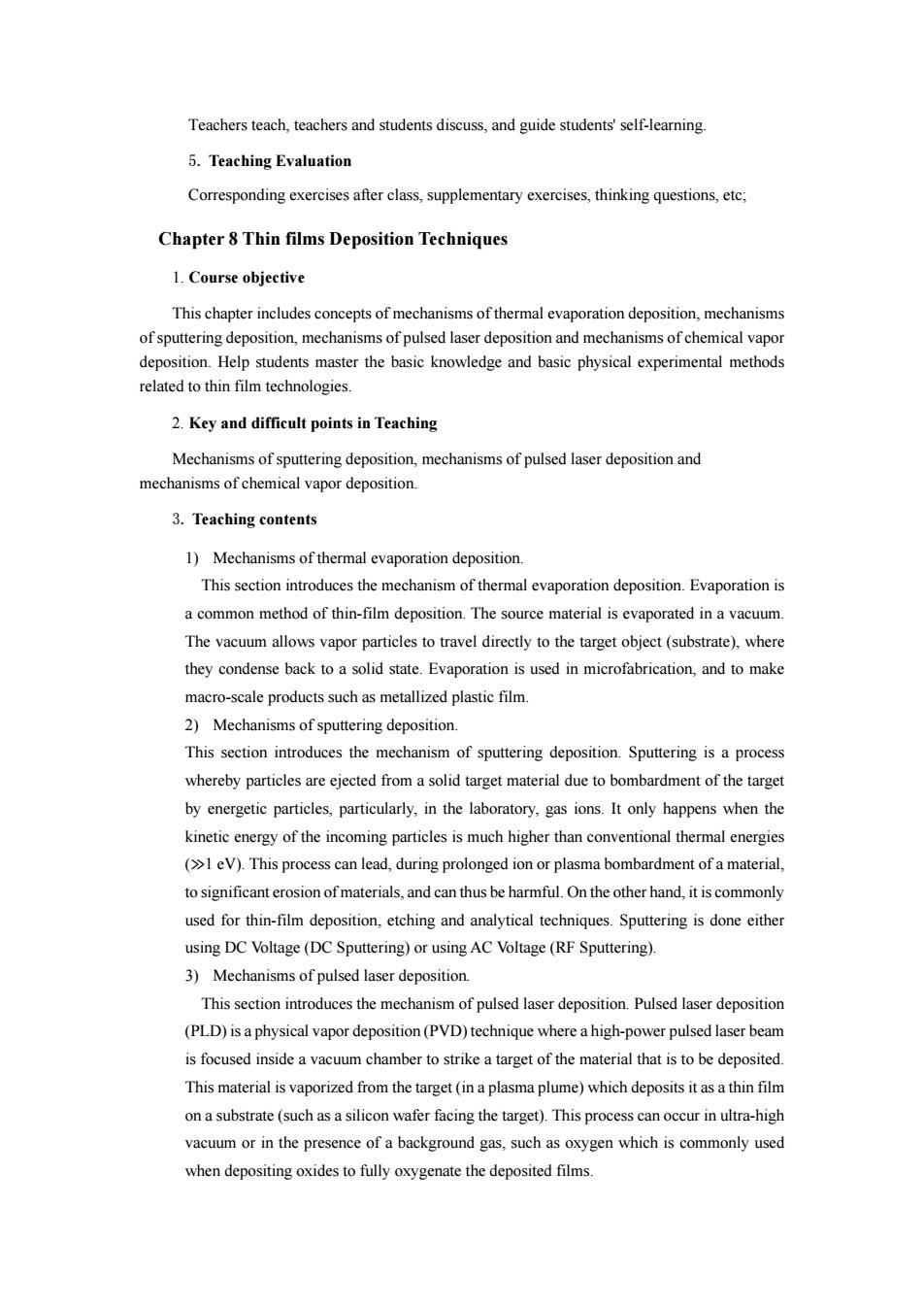正在加载图片...

Teachers teach,teachers and students discuss,and guide students'self-learning 5.Teaching Evaluation Corresponding exercises after class,supplementary exercises,thinking questions,etc Chapter 8Thin films Deposition Techniques 1.Course objective This chapter includes concepts of mechanisms of thermal evaporation deposition,mechanisms of sputtering mechanisms of pulsed mechanisms of chemical vapor dpostion.Helpdcnsm ster the basic knowledge and basi methd related to thin film technologies 2.Key and difficult points in Teaching Mechanisms of sputtering deposition,mechanisms of pulsed laser deposition and mechanisms of chemical vapor deposition 3.Teaching content 1)Mechanisms of thermal evaporation deposition. This section introduces the mechanism of thermal evaporation deposition.Evaporation is a common method of thin-film deposition.The source material is evaporated in a vacuum. The vacuum allows vapor particles to travel directly to the target object(substrate),where they condense back to a solid state.Evaporation is used in microfabrication,and to make macro-scale products such as metallized plastic film 2)Mechanisms of sputtering deposition. This section introduces the mechanism of sputtering deposition.Sputtering is a process whereby particles are ejected from asolid target materialdue to bombardment of the target by energetic particles,particularly.in the laboratory,gas ions.It only happens when the kinetic energy of the incoming partices is much higher than conventionl thermal nergies (eV).This process can lead,during prolonged ion or plasma bombardment of a material, materials,and can thus be harmful.On the other hand,it iscommonly used for thin-film deposition,etching and analytical techniques.Sputtering is done either using DC Voltage(DC Sputtering)or using AC Voltage(RF Sputtering). 3)Mechanisms of pulsed laser deposition. the mechanism of pulsed aser deposition Pulsed aser deposition (PLD)isaphysical vapor deposition(PVD)technique where ahigh-power pulsed laser beam is focused inside a vacuum chamber tostrike a target of the material that is tobe deposited. This material is vaporized from the target(in a plasma plume)which deposits it as a thin film on asubstrate(such as asilicon wafer facing the target).This process canoccur in ultra-high vacuum or in the presence of a background gas,such as oxygen which is commonly used when depositing oxides to fully oxygenate the deposited films Teachers teach, teachers and students discuss, and guide students' self-learning. 5. Teaching Evaluation Corresponding exercises after class, supplementary exercises, thinking questions, etc; Chapter 8 Thin films Deposition Techniques 1. Course objective This chapter includes concepts of mechanisms of thermal evaporation deposition, mechanisms of sputtering deposition, mechanisms of pulsed laser deposition and mechanisms of chemical vapor deposition. Help students master the basic knowledge and basic physical experimental methods related to thin film technologies. 2. Key and difficult points in Teaching Mechanisms of sputtering deposition, mechanisms of pulsed laser deposition and mechanisms of chemical vapor deposition. 3. Teaching contents 1) Mechanisms of thermal evaporation deposition. This section introduces the mechanism of thermal evaporation deposition. Evaporation is a common method of thin-film deposition. The source material is evaporated in a vacuum. The vacuum allows vapor particles to travel directly to the target object (substrate), where they condense back to a solid state. Evaporation is used in microfabrication, and to make macro-scale products such as metallized plastic film. 2) Mechanisms of sputtering deposition. This section introduces the mechanism of sputtering deposition. Sputtering is a process whereby particles are ejected from a solid target material due to bombardment of the target by energetic particles, particularly, in the laboratory, gas ions. It only happens when the kinetic energy of the incoming particles is much higher than conventional thermal energies (≫1 eV). This process can lead, during prolonged ion or plasma bombardment of a material, to significant erosion of materials, and can thus be harmful. On the other hand, it is commonly used for thin-film deposition, etching and analytical techniques. Sputtering is done either using DC Voltage (DC Sputtering) or using AC Voltage (RF Sputtering). 3) Mechanisms of pulsed laser deposition. This section introduces the mechanism of pulsed laser deposition. Pulsed laser deposition (PLD) is a physical vapor deposition (PVD) technique where a high-power pulsed laser beam is focused inside a vacuum chamber to strike a target of the material that is to be deposited. This material is vaporized from the target (in a plasma plume) which deposits it as a thin film on a substrate (such as a silicon wafer facing the target). This process can occur in ultra-high vacuum or in the presence of a background gas, such as oxygen which is commonly used when depositing oxides to fully oxygenate the deposited films